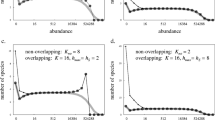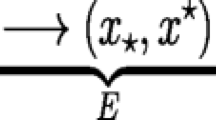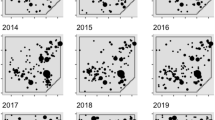Abstract
Natural communities at all spatiotemporal scales are subjected to a wide variety of environmental pressures, resulting in random changes in the demographic rates of species populations. Previous analyses have examined the effects of such environmental variance on the long-term growth rate and time to extinction of single populations, but studies of its effects on the diversity of communities remain scarce. In this study, we construct a new master-equation model incorporating demographic and environmental variance and use it to examine how statistical patterns of diversity, as encapsulated by species-abundance distributions (SADs), are altered by environmental variance. Unlike previous diffusion models with environmental variance uncorrelated in time (white noise), our model allows environmental variance to be correlated at different timescales (colored noise), thus facilitating representation of phenomena such as yearly and decadal changes in climate. We derive an exact analytical expression for SADs predicted by our model together with a close approximation, and use them to show that the main effect of adding environmental variance is to increase the proportion of abundant species, thus flattening the SAD relative to the log-series form found in the neutral case. This flattening effect becomes more prominent when environmental variance is more correlated in time and has greater effects on species’ demographic rates, holding all other factors constant. Furthermore, we show how our model SADs are consistent with those from diffusion models near the white noise limit. The mathematical techniques we develop are catalysts for further theoretical work exploring the consequences of environmental variance for biodiversity.




Similar content being viewed by others
References
Allen AP, Savage VM (2007) Setting the absolute tempo of biodiversity dynamics. Ecol. Lett. 10:637–646
Ariño A, Pimm SL (1995) The nature of population extremes. Evol. Ecol. 9:429–443
Azaele S, Pigolotti S, Banavar JR, Maritan A (2006) Dynamical evolution of ecosystems. Nature 444:926–928
Bell G (2000) The distribution of abundance in neutral communities. Am. Nat. 155:606–617
Bell G (2001) Neutral macroecology. Science 293:2413–2418
Benton TG, Lapsley CT, Beckerman AP (2002) The population response to environmental noise: population size, variance and correlation in an experimental system. J. Anim. Ecol. 71:320–322
Caswell H (1976) Community structure: a neutral model analysis. Ecol. Monogr. 46:327–354
Caswell H, Cohen JE (1995) Red, white and blue: environmental variance spectra and coexistence in metapopulations. J. Theor. Biol. 176:301–316
Chesson P (1991) Stochastic population models. In: Kolasa J, Pickett STA (eds) Ecological Heterogeneity. Springer-Verlag, New York, pp 123–143
Chisholm RA, Lichstein JW (2009) Linking dispersal, immigration and scale in the neutral theory of biodiversity. Ecol. Lett. 12:1385–1393
Chisholm RA, Pacala SW (2010) Niche and neutral models predict asymptotically equivalent species abundance distributions in high-diversity ecological communities. Proc. Natl. Acad. Sci. USA 107:15821–15825
Chisholm RA, O’Dwyer JP (2014) Species ages in neutral biodiversity models. Theor. Popul. Biol. 93:85–94
Chisholm RA et al (2014) Temporal variability of forest communities: empirical estimates of population change in 4000 tree species. Ecol. Lett. 17:855–865
Doering CR, Sargsyan KV, Sander LM (2005) Extinction times for birth-death processes: exact results, continuum asymptotics, and the failure of the Fokker–Planck approximation. Multiscale Model. Sim. 3:283–299
Engen S, Lande R (1996a) Population dynamic models generating species abundance distributions of the gamma type. J. Theor. Biol. 178:325–331
Engen S, Lande R (1996b) Population dynamic models generating the lognormal species abundance distribution. Math. Biosci. 132:169–183
Engen S, Lande R, Walla T, DeVries PJ (2002) Analyzing spatial structure of communities using the two-dimensional poisson lognormal species abundance model. Am. Nat. 160:60–73
Engen S, Aagaard K, Bongard T (2011) Disentangling the effects of heterogeneity, stochastic dynamics and sampling in a community of aquatic insects. Ecol. Model. 222:1387–1393
Etienne RS, Alonso D, McKane AJ (2007) The zero-sum assumption in neutral biodiversity theory. J. Theor. Biol. 248:522–536
Fisher RA, Corbet AS, Williams CB (1943) The relation between the number of species and the number of individuals in a random sample of an animal population. J. Anim. Ecol. 74:1131–1139
Foley P (1994) Predicting extinction times from environmental stochasticity and carrying capacity. Conserv. Biol. 8:124–137
Gyllenberg M, Högnäs G, Koski T (1994) Population models with environmental stochasticity. J. Math. Biol. 32:93–108
Halley JM (1996) Ecology, evolution and 1/f-noise. Trends Ecol. Evol. 11:33–37
Halley JM, Iwasa Y (1998) Extinction rate of a population under both demographic and environmental stochasticity. Theor. Popul. Biol. 53:1–15
Halley JM, Iwasa Y (2011) Neutral theory as a predictor of avifaunal extinctions after habitat loss. Proc. Natl. Acad. Sci. USA 108:2316–2321
Heino M, Ripa J, Kaitala V (2000) Extinction risk under coloured environmental noise. Ecography 23:177–184
Heino M, Sabadell M (2003) Influence of coloured noise on the extinction risk in structured population models. Biol. Conserv. 110:315–325
Hubbell SP (1997) A unified theory of biogeography and relative species abundance and its application to tropical rainforests and coral reefs. Coral Reefs 16(Suppl.):S9–S21
Hubbell SP (2001) The Unified Neutral Theory of Biodiversity and Biogeography. Princeton University Press, Princeton
Inchausti P, Halley J (2002) The long-term temporal variability and spectral colour of animal populations. Evol. Ecol. Res. 4:1033–1048
Kaitala V, Ranta E (1996) Red/blue chaotic power spectra. Nature 381:198–199
Kaitala V, Ylikarjula J, Ranta E, Lundberg P (1997) Population dynamics and the colour of environmental noise. Proc. R. Soc. Lond. B Biol. 264:943–948
Kalyuzhny M, Schreiber Y, Chocron R, Flather CH, Kadmon R, Kessler DA, Shnerb NM (2014a) Temporal fluctuation scaling in populations and communities. Ecology 95:1701–1709
Kalyuzhny M, Seri E, Chocron R, Flather CH, Kadmon R, Shnerb NM (2014b) Niche versus neutrality: a dynamical analysis. Am. Nat. 184:439–446
Kalyuzhny M, Kadmon R, Shnerb NM (2015) A neutral theory with environmental stochasticity explains static and dynamic properties of ecological communities. Ecol. Lett. 18:572–580
Kamenev A, Meerson B, Shklovskii B (2008) How colored environmental noise affects population extinction. Phys. Rev. Lett. 101:268103
Kemeny JG, Snell JL (1960) Finite Markov Chains. Van Norstrand, Princeton
Kessler DA, Shnerb NM (2014) Neutral-like abundance distributions in the presence of selection in a continuous fitness landscape. J. Theor. Biol. 345:1–11
Lande R (1993) Risks of population extinction from demographic and environmental stochasticity and random catastrophes. Am. Nat. 142:911–927
Lande R, Engen S, Sæther BE (2003) Stochastic Population Dynamics in Ecology and Conservation. Oxford University Press, Oxford
Leigh EG (1981) The average lifetime of a population in a varying environment. J. Theor. Biol. 90:213–239
Lotka AJ (1920) Undamped oscillations derived from the law of mass action. J. Am. Chem. Soc. 24:254–262
Lotka AJ (1925) Elements of Physical Biology. Williams and Wilkins, Baltimore
MacArthur R, Levins R (1967) The limiting similarity, convergence, and divergence of coexisting species. Am. Nat. 101:377–385
Manrubia SC, Zanette DH (2002) At the boundary between biological and cultural evolution: the origin of surname distributions. J. Theor. Biol. 216:461–477
Mantua, N.J.: Pacific-Decadal Oscillation (PDO). In: MacCracken, M.C., Perry, J.S. (eds.) The Earth System, Physical and Chemical Dimensions of Global Environmental Change. Wiley, Chichester, pp. 592–594 (2002)
Maruvka YE, Shnerb NM, Kessler DA (2010) Universal features of surname distribution in a subsample of a growing population. J. Theor. Biol. 262:245–256
Maruvka YE, Shnerb NM, Kessler DA (2011) The birth-death-mutation process: a new paradigm for fat tailed distributions. PLoS One 6:e26480
Maruvka YE, Shnerb NM, Kessler DA, Ricklefs RE (2013) Model for macroevolutionary dynamics. Proc. Natl. Acad. Sci. USA 27:E2460–E2469
Melbourne BA, Hastings A (2008) Extinction risk depends strongly on factors contributing to stochasticity. Nature 454:100–103
Méndez V, Llopis I, Campos D, Horsthemke W (2010) Extinction conditions for isolated populations affected by environmental stochasticity. Theor. Popul. Biol. 77:250–256
Mode CJ, Jacobson ME (1987a) A study of the impact of environmental stochasticity on extinction probabilities by Monte Carlo integration. Math. Biosci. 83:105–125
Mode CJ, Jacobson ME (1987b) On estimating critical population size for an endangered species in the presence of environmental stochasticity. Math. Biosci. 85:185–209
Morales JM (1999) Viability in a pink environment: why “white noise” models can be dangerous. Ecol. Lett. 2:228–232
Nee S (2005) The neutral theory of biodiversity: do the numbers add up? Funct. Ecol. 19:173–176
O’Dwyer JP, Green JL (2010) Field theory for biogeography: a spatially explicit model for predicting patterns of biodiversity. Ecol. Lett. 13:87–95
O’Dwyer JP, Chisholm R (2014) A mean field model for competition: from neutral ecology to the Red Queen. Ecol. Lett. 17:961–969
Ovaskainen O, Meerson B (2010) Stochastic models of population extinction. Trends Ecol. Evol. 25:643–652
Petchey OL (2000) Environmental colour affects aspects of single-species population dynamics. Proc. R. Soc. Lond. B Biol. 267:747–754
Pimm SL, Redfearn A (1988) The variability of population densities. Nature 334:613–614
Preston FW (1948) The commonness and rarity of species. Ecology 29:254–283
Preston FW (1962a) The canonical distribution of commonness and rarity: part I. Ecology 43:185–215
Preston FW (1962b) The canonical distribution of commonness and rarity: part II. Ecology 43:410–432
Reuman DC, Desharnais RA, Costantino RF, Ahmad OS, Cohen JE (2006) Power spectra reveal the influence of stochasticity on nonlinear population dynamics. Proc. Natl. Acad. Sci. USA 103:18860–18865
Ripa J, Lundberg P (1996) Noise colour and the risk of population extinctions. Proc. R. Soc. Lond. B Biol. 263:1751–1753
Ruokolainen L, Linden A, Kaitala V, Fowler MS (2009) Ecological and evolutionary dynamics under coloured environmental variation. Trends Ecol. Evol. 24:555–563
Schreiber SJ (2010) Interactive effects of temporal correlations, spatial heterogeneity and dispersal on population persistence. Proc. R. Soc. Lond. B Biol. 277:1907–1914
Schwager M, Johst K, Jeltsch R (2006) Does red noise increase or decrease extinction risk? Single extreme events versus series of unfavorable conditions. Am. Nat. 167:879–888
Steele JH (1985) A comparison of terrestrial and marine ecological systems. Nature 313:355–358
Vallade M, Houchmandzadeh B (2003) Analytical solution of a neutral model of biodiversity. Phys. Rev. E 68:061902
Volkov I, Banavar JR, Hubbell SP, Maritan A (2003) Neutral theory and relative species abundance in ecology. Nature 424:1035–1037
Volkov I, Banavar JR, Hubbell SP, Maritan A (2007) Patterns of relative species abundance in rainforests and coral reefs. Nature 450:45–49
Volterra, V.: Variazioni e fluttuazioni del numero d’individui in specie animali conviventi. Memorie Della R. Academia Nazionale Dei Lincei 2, 31–113 (1926)
Xu C-L, Li Z-Z (2003) Population dynamics and the color of environmental noise: a study on a three-species food chain system. Ecol. Res. 18:145–154
Acknowledgments
TF and RAC are supported by the National University of Singapore grants WBS R-154-000-603-112 and R-154-000-560-651. JPOD acknowledges support from the Templeton World Charity Foundation grant TWCF0079/AB47. We also thank Jin Yi Lau, Felix Lim and Francesca McGrath for constructive discussions on the work presented.
Author information
Authors and Affiliations
Corresponding author
Electronic supplementary material
Below is the link to the electronic supplementary material.
Rights and permissions
About this article
Cite this article
Fung, T., O’Dwyer, J.P. & Chisholm, R.A. Species-abundance distributions under colored environmental noise. J. Math. Biol. 74, 289–311 (2017). https://doi.org/10.1007/s00285-016-1022-4
Received:
Revised:
Published:
Issue Date:
DOI: https://doi.org/10.1007/s00285-016-1022-4
Keywords
- Colored noise
- Demographic variance
- Environmental variance
- Fokker–Planck equation
- Master equation
- Species-abundance distribution




